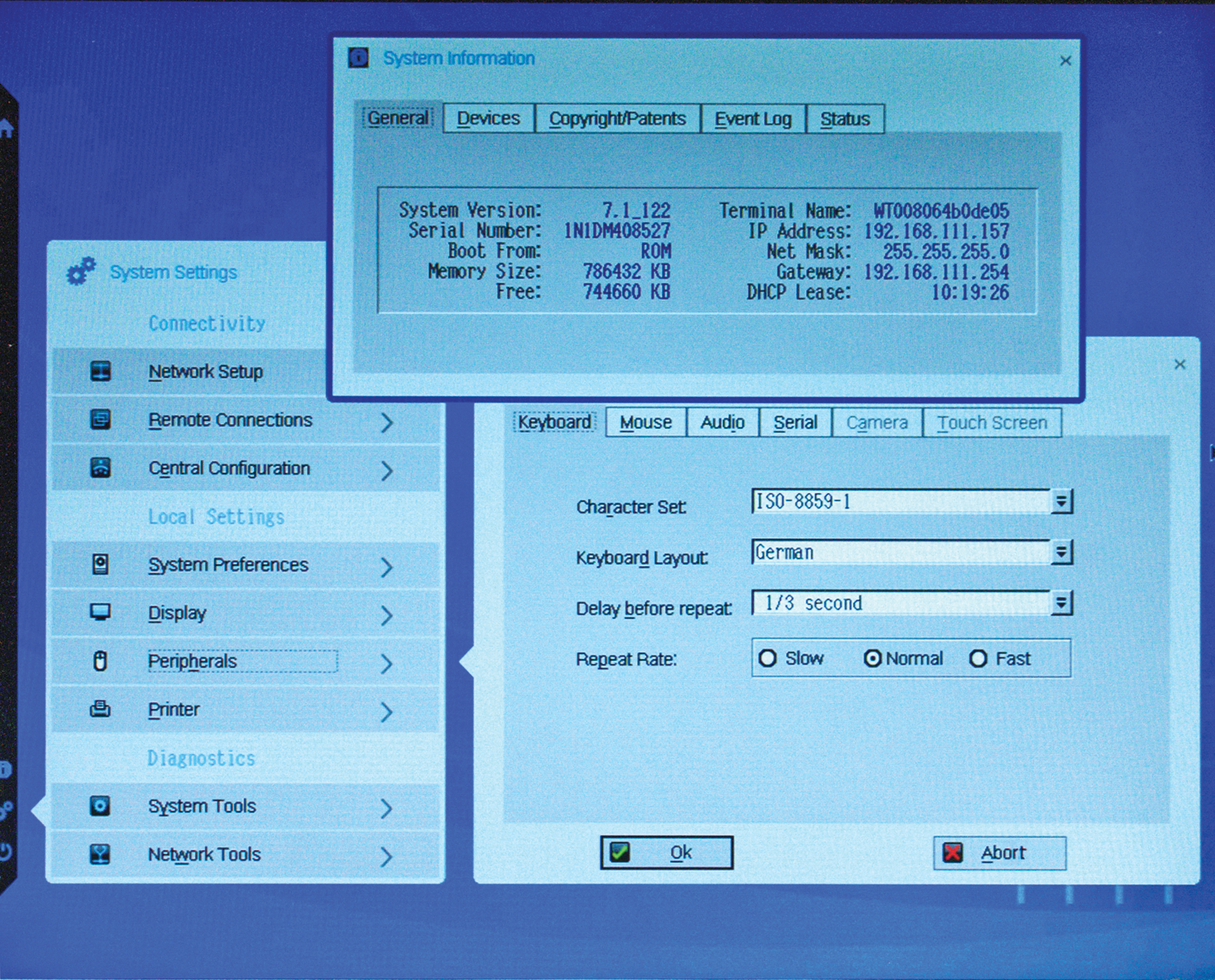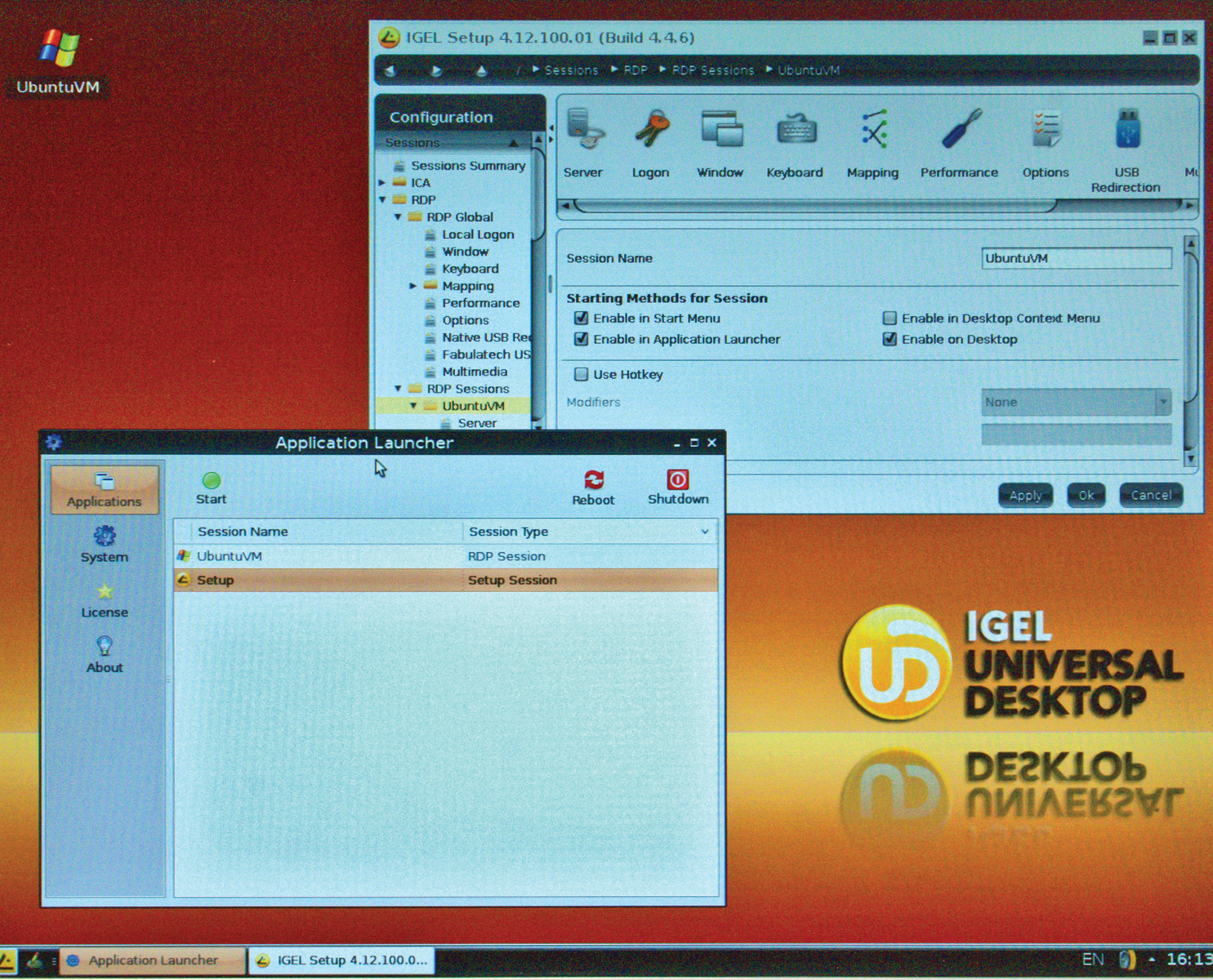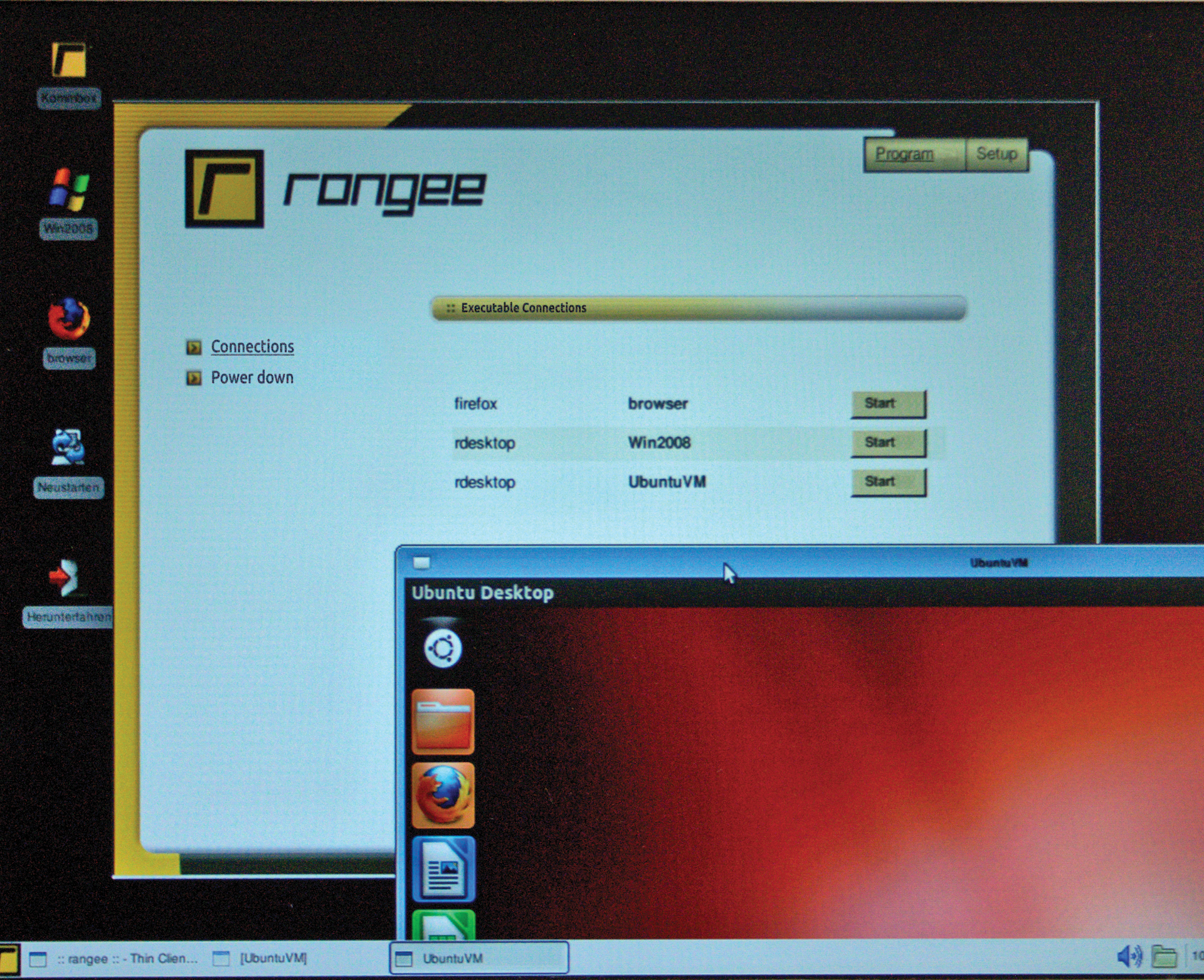
Five multipurpose thin clients compared
Lean andStrong
There is no such thing as the best thin client. Nevertheless, in this article I compare five representative models – why? Because the thin client certainly is the best device for a particular purpose. The intended application determines how practical and inexpensive a certain thin client is.
If the application only uses text-based menus and ASCII art, if you do not need to connect to local peripherals, and if response time is not critical, your needs will certainly be well served with an inexpensive entry-level model. However, if you want to work with multiple monitors or even handle multimedia content to a significant extent, the entry-level choice is not optimal. Additionally, if you need special interfaces, you will have to look for a thin client that is equipped with them.
The choice is quite varied. We picked five fairly universal models, including entry-level devices and their better-equipped competitors (see Table 1).
Tabelle 1: Thin Client Comparison
|
Manufacturer |
Rangee GmbH |
IGEL Technology GmbH |
Fujitsu |
Wyse Technology GmbH |
Wyse Technology GmbH |
|
Price |
approx. EUR 375 |
approx. US$ 435 |
approx. US$ 450 |
approx. US$ 600 |
approx. US$ 335 |
|
CPU |
Via Eden X2/1GHz |
Via Eden X2/1GHz |
AMD G-T44R/1.2GHz |
AMD G-T56N/1.6GHz |
Marvell ARMADA PXA 510 v7.1 |
|
Chipset |
Via VX900 |
Via VX900 |
AMD A55E |
AMD G-Series A50M |
PXA 510 v7 |
|
Graphics processor |
Via Chrome 9, integrated |
Via Chrome 9, integrated |
AMD Radeon HD 6250, integrated |
AMD Radeon HD 6320, integrated |
Integrated/SoC |
|
Graphics memory |
Up to 512MB |
128MB |
256MB |
384MB |
256MB |
|
RAM |
1GB |
1GB |
2GB |
4GB |
1GB |
|
Flash |
1GB |
2GB |
2GB |
8GB |
0GB |
|
Speaker |
Yes |
Yes |
Yes |
Yes |
Yes |
|
Card reader |
No |
Yes |
Optional |
No |
No |
|
PCI slot |
No |
No |
Optional |
Only with Z90DE7 |
No |
|
PCMCIA slot |
No |
No |
No |
No |
No |
|
Power supply |
Fanless, external |
Fanless, external |
Fanless, external |
Fanless, external |
Fanless, external |
|
Power draw |
Active: 11W; sleep: <1W |
Active: 9W; sleep: 1W |
Active: >10W; sleep: 1W |
Active 10-15W; sleep: 0.86W |
Active: 7.2W; sleep: 1.8W |
|
Size (LxWxH): |
140x42x198mm |
227x82x231mm |
191x97x266mm |
225x47x200mm |
119x25x177mm |
|
Weight: |
1.2kg |
1.44kg |
1.3kg |
1.12kg |
0.455kg |
|
Operating system |
RangeeLinux |
IGEL Linux |
eLux RL |
Windows Embedded |
ThinOS |
|
Kernel |
3.3.2 |
3.2.30 |
2.6.38.4 |
6.01 SP 1 |
Firmware 7.1_207 |
|
X server |
X.Org 7.5 |
X.Org |
X.Org 7.7.1 |
– |
- |
|
Session protocols |
|||||
|---|---|---|---|---|---|
|
Browser |
Firefox |
Firefox |
Firefox |
Internet Explorer |
No |
|
ICA |
Yes, S-Model |
Yes |
Yes |
Yes |
Yes |
|
NoMachine NX |
Yes, X-Model |
Yes |
No |
No |
No |
|
RDP/FreeRDP |
Yes, S-Model |
Yes |
Yes |
Yes |
Yes |
|
VMware View client |
Yes, S-Model |
Yes |
Yes |
Yes |
Yes |
|
Citrix HDX |
Yes, X-Model |
Yes |
Yes |
Yes |
No |
|
XDMCP |
Yes, X-Model |
Yes |
Yes |
No |
No |
|
Thinprint |
No |
Yes |
Optional |
No |
No |
|
SSH |
Yes |
Yes |
Yes |
No |
No |
|
Interfaces |
|||||
|
USB |
5x USB 1.1/2.0(1) |
4x USB 2.0 |
8x USB 2.0(2) |
4x USB 2.0, 2x USB 3.0 |
4x USB 2.0 |
|
PS/2 |
1x |
1x |
2x |
Optional |
No |
|
Serial |
No |
Optional via Connectivity Foot |
2x |
Optional |
No |
|
Parallel |
No |
No |
No |
Optional |
No |
|
DVI |
DVI-D + DVI-I |
DVI-D + DVI-I |
DVI-I |
DVI-I |
DVI-I |
|
CRT/VGA |
Via adapter |
Via adapter |
Via adapter |
Via adapter |
Via adapter |
|
LAN |
1x 10/100/1000-Base-T |
1x 10/100/1000-Base-T |
1x 10/100/1000-Base-T |
1x 10/100/1000-Base-T |
1x 10/100/1000-Base-T |
|
Microphone |
Yes |
Yes |
Yes |
Yes |
Yes |
|
Line out |
Yes |
Yes |
Yes |
Yes |
Yes |
|
Network options |
|||||
|
IP via DHCP |
Yes |
Yes |
Yes |
Yes |
Yes |
|
WLAN |
Optional via USB stick |
Optional via Connectivity Foot |
Optional |
Optional |
Optional |
|
VLAN |
Yes |
No |
No |
Yes |
No |
|
Active Directory connection |
Yes |
Yes |
Yes |
Yes |
No |
|
Mounting NFS shares |
Yes |
Yes |
No |
Yes |
No |
|
Mounting SMB shares |
Yes |
Yes |
Yes |
Yes |
No |
|
Comments |
|||||
|
(1) One slot under the top cover. (2) Two of which are internal |
|||||
Dell Wyse T10
The small device by Dell Wyse costs about US$ 335 and thus costs less than any other device in this test; however, this entry-level device does not fare well in feature comparison with the better-equipped candidates. However, the 500-gram lightweight unit can be mounted easily on the back of the monitor and can be retrofitted with WiFi.
Our test unit had a conventional Gigabit LAN port, a DVB-I port, and four USB 2.0 ports, as well as audio in and out. That's not overly generous, but it is adequate for many purposes. Additionally, this frugality benefits power consumption, which is amazingly low at about 7 watts in normal operation.
The Thin OS graphical user interface seems a bit spartan (Figure 1) and does not offer many options, but it's functional and easy to use. The supported session protocols are ICA or RDP but include nothing more exotic and no browser.

Interaction with a Citrix XenServer or VMware View Connection Broker is possible, and the thin client also supports the Quest Software or Leostream VDI brokers and Windows Terminal Server.
Even the small Wyse T10 client can be managed using the Wyse Device Manager (WDM), which can handle thousands of thin clients from a central location.
IGEL UD3-740 LX Advanced
The interface of the IGEL, Linux version, is divided into the Setup and Application Launcher sections and offers well-structured menus with a wealth of options (Figure 2). They include the obligatory ICA and RDP protocols, as well as support for the Horizon and vWorkspace clients for Leostream and the NX and 2X clients and SAP sessions for the PowerTerm and IBM iSeries terminals.

Java Web Services or the Linux ThinLinc remote desktop server also can be supported. A built-in browser is provided, of course, along with a VoIP client that transforms the thin client into a phone.
IGEL Linux also provides detailed hardware information and configuration options for locally attached peripherals, such as storage or printers with tools similar to those found in the desktop environments of popular distributions. Diagnostic tools are available for troubleshooting network problems. On the hardware side, the device from IGEL impresses with an integrated smart card reader that allows any user to log in securely, quickly, and conveniently via two-factor authentication.
In addition to a DVI-I port, the current model also has a purely digital DVI-D port, so you can run two monitors at the same time in a dual-view configuration. An optional special foot contains a serial interface and can accommodate wireless technology.
Most thin client vendors provide centralized management tools with which large numbers of their clients can be updated and configured centrally. In the case of IGEL, this tool is called the Universal Management Suite, and you can use the suite to manage this versatile device, too.
Rangee S-L700-L
Like the IGEL, the Rangee comes with two DVI ports and is thus particularly recommended for workplaces where you want to work with two monitors. The model we tested did not have a card reader, unlike the IGEL, but the fairly wide Rangee product portfolio also includes devices with smartcard readers.
The rest of the hardware equipment is largely consistent with the common denominator in our test: four externally accessible USB ports, Gigabit network, audio in and out, one PS/2 for keyboard or mouse. A special feature of the Rangee is a fifth USB port inside the box when you remove the top cover. You can connect a WLAN stick here.
The Rangee's GUI (Figure 3) feels somewhat minimalist, but it is straightforward and lends itself to intuitive operation. Just as with the hardware, it is also important in terms of Rangee's software features that you buy the right product for your needs: Although you can find an answer to almost every need, you will find no all-arounders; instead, the options are distributed across multiple specialized devices.

Rangee's management solution goes by the name of Thin Client Management Server (TCMS), and it successfully managed the device we tested. TCMS itself can be installed on a thin client or on a virtual machine and works over WAN if needed.
Fujitsu Futro S900
The Fujitsu Futro S900 can also be ordered with Windows Embedded, but our model had eLux RL – a Linux derivative, as the name suggests. It also offers a neat and functional interface for all settings (Figure 4).

In terms of hardware, Futro's unique feature among all our test candidates is the PCI slot that can, for example, house a second graphics card. However, dual monitoring is already supported by the standard DVI port along with the DisplayPort. This device was the only thin client to include a USB keyboard and mouse. Additionally, it was the only one with serial ports, which are useful for terminal emulation. The software supports a wide range of terminal types.
The supported session protocols are once again RDP and ICA; less common offerings are missing. However, you can use Leostream and VMware View and Citrix Xen Desktop as VDI brokers. Remote maintenance of the client via a centralized application, known as Scout Enterprise, is possible.
All told, the Futro presents itself as a well-equipped and extensible solution that also returned the fastest performance, by a narrow margin, in our benchmark (see the "Thin Client Benchmark" box).
Dell Wyse Z90D7
The larger model by Wyse – the US thin client manufacturer was acquired by Dell in 2012 – was the only one in our test field that did not use a Linux derivative. Instead, it booted Windows Embedded Standard 7 (Figure 6). This immediately gives users the feeling of not just having a runtime environment for configuration utilities, but a full-fledged operating system that includes media players, desktop accessories, and gadgets. Additionally, users can benefit from the ability to run 32-bit Windows applications locally – including support for desktop peripherals.

This thin client supports VMware and Citrix Sessions for standard protocols without any problems but has to pass on more exotic connection types. As with the smaller model, remote management of the device is possible.
In terms of hardware, the Wyse Z90 impresses with two USB 3.0 ports, which no other competitor in our test field provided. They are about 10 times faster than USB 2.0, which is also on board. Like the Futro by Fujitsu, the Z90 also has a DisplayPort connector. Its energy-efficient AMD G-Series processor provides good performance and, although the Radeon HD 6320 graphics card is not suitable for gaming, it is fine for office applications.
Conclusions
All thin clients featured here are small, quiet, virtually maintenance-free, and energy efficient. All can be managed from a central location, and all can handle the basic communication protocols for environments by VMware, Citrix, and Microsoft. The differences lie in the details that predestine these devices for different scenarios. If you analyze your requirements, you are certain to find a client tailored to your applications and performance needs.
